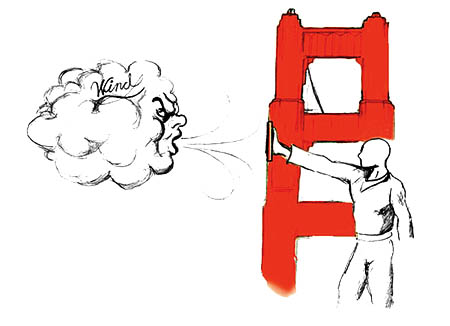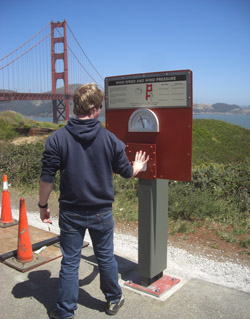The Golden Gate is a very breezy place, the only gap in the coast range for hundreds of miles. Cool, dense, high pressure air over the cold ocean pushes its way into the Bay and California’s interior, while the land heats up and the air over it becomes warmer, less dense, and lower in pressure. This exhibit allows the visitor to feel how much harder it is to push with a force equivalent to a wind of various speeds.

When wind pressure pushes on the Golden Gate Bridge, the Bridge must push back with enough force to stand up and remain stable.
When the wind blows twice as fast, the pressure is not twice as great - it is four times as great.
Wind pressure, in this case the wind force spread over 1 square foot (1/10 meter square), increases as the square of the wind speed.
More Images
 |
This exhibit allows the visitor to feel how much harder it is to push with a force equivalent to a wind of various speeds. |
Explore this Topic Further
Wind and the Golden Gate Bridge
The Wind Speed at the Golden Gate from willyweather.com (all ages)
Find out how fast the wind is blowing through the Golden Gate at this minute.
Bridge Closure due to Wind from the Golden Gate Bridge, Highway and Transportation District (all ages)
The Bridge was closed three times because of wind. Find out when!
Bridge Deck Aerodynamics (all ages)
This exhibit, in the visitor area at the San Francisco end of the Bridge, demonstrates the importance of the shape of the bridge deck cross section in the stability of a suspension bridge.
Bridge Deck Torsional Resistance Retrofit (all ages)
This exhibit, in the visitor area at the San Francisco end of the Bridge, describes the bracing that was added to the bottom of the Bridge deck to improve performance of the Bridge when exposed to high winds.
Wind Study, Golden Gate Bridge from Golden Gate Bridge, Highway and Transportation District (technical engineering research report by Jon Raggett, West Wind Laboratory, Inc.)
This report documents wind tunnel and analytical studies of different suicide-prevention barrier designs. The difference in the effect of seemingly small design variations of fence-like barriers along the length of the Bridge on its aerodynamic performance is greater than the layperson might assume. It is an example of the detailed attention engineers must pay to the cross-section of a suspension bridge deck, including the shape of guard rails.
Wind Formation and Characteristics
Origin of Wind from National Oceanic and Atmospheric Administration (grade 3 to adult)
Wind is caused by movement of air from high to low pressure areas. This web page summarizes the basic science and vocabulary of wind formation.
How Wind is Formed from Meteorologist Scott Dorvall (grade 3 to adult)
Meteorologist Scott Dorvall from Fox9 discusses how wind is formed and why some cities are winder than others. (2:14 minute video)
Beaufort Wind Scale from National Oceanic and Atmospheric Administration (grade 3 to adult)
The Beaufort wind force scale is an internationally recognized standard for relating observed conditions on land or at sea to wind speed. A Beaufort number of 12 indicates winds of at least "hurricane force," 74 mph (119 kph).
Hands-On Activities
Measuring the Wind from tryengineering.org (grades 3 to 12)
This lesson developed by the IEEE(Institute of Electrical and Electronics Engineers) introduces students to measuring wind speed with anemometers. The lesson, aligned with national science and technology standards, takes students through the steps of designing, constructing, and testing their own anemometer.
Loads on Bridges Interactive Lab from PBS Building Big (grades 3 to 6)
Using short interactive applications, students explore the loads that act on bridges including gravity, temperature, wind, earthquake, vibration, and ground settlement.